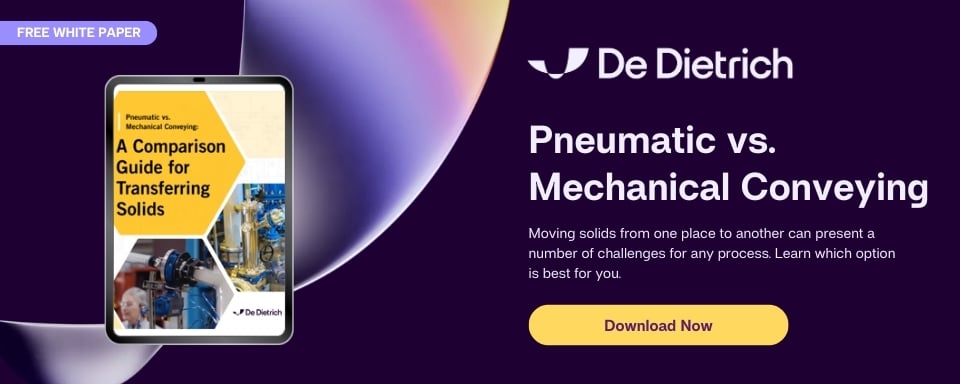Things to Know about Bulk Bags
One of the most common types of containers used to package solids or powders in larger quantities are “bulk bags”, which are also known as big bags, super sacks or FIBC’s (Flexible Intermediate Bulk Container).
Over the years, De Dietrich has supplied numerous pneumatic conveying systems to efficiently remove the contents from bulk bags and convey them in a safe and contained manner. Based on this experience, we know what information is important to have and consider when designing these type systems, and some of the most critical details involve the design of various parts of the bulk bag itself.
Bulk Bag Components
While bulk bags are relatively simple in design, there are some variable features that need to be determined when selecting one to best meet your material handling requirements. Following is an illustration and top to bottom list of these components:

- Fill Spout or Top Spout – This is the flexible sleeve typically located in the center of the top panel through which material enters when the container is being filled.
- Lifting Loops – These are usually closed-loop straps 8-12 inches long located at the four corners of the top panel. These type of loops are the most common and easiest to use with bag filling and emptying stations, but they can be supplied in other configurations including corner straps (connects with the adjacent corner) or cross-corner straps.
- Bag Body – The bag body is the rectangular portion in which the solids or powders are held. The length, width and height of the body are critical when designing a system. For instance, the height of this section will ultimately affect the overall stack-up height of the equipment, and the total volume will determine the system’s lifting capacity based on the bulk density of the material.
- Liner – When a product is moisture/air sensitive, very fine or toxic, an impermeable liner can be used to keep the product better contained. It is important to know how these liners are attached to the inside of the bag and the dimensions associated with it.
- Bottom Spout – The bottom spout is used to empty solids/powder from a bulk bag. Knowing the spout length, spout diameter and location of the cinch-tie closure on the spout are all critical to designing the system’s interface with the spout to enable dust-free handling. Often, a spout clamping device is used to secure the spout onto a material discharge nozzle, and a spout closure device is used to prevent material flow while untying the cinch-tie on the spout.
Types of Bulk Bags
In addition to understanding the parts of a bulk bag, it is also important to know that there are different types of super sacks as well. Each of these types relates to the ignition sensitivity of the material being handled inside the bulk bag. There are four types, and they are categorized by the MIE (Minimum Ignition Energy) of the material inside. Below is a breakdown of them:
- Type A – An FIBC made from nonconductive fabric with no special design features for control of electrostatic discharge hazards. Used with materials having MIE > 1,000 millijoules (mJ).
- Type B – An FIBC made from nonconductive fabric where the fabric or the combination of the shell fabric, fabric coating, and any loose liner has a breakdown voltage of less than 6,000 volts. Used with materials having an MIE > 3 mJ.
- Type C – An FIBC made from conductive material or nonconductive woven fabric incorporating interconnected conductive threads of specified spacing with all conductive components connected to a grounding tab. Used with materials having an MIE ≤ 3 mJ.
- Type D – An FIBC made from fabric and/or threads with special static properties designed to control electrostatic discharge energy without a requirement for grounding the FIBC. Used with materials having an MIE ≤ 3 mJ.
The information above can also be found in NFPA 652: Standard on the Fundamentals of Combustible Dust.
Whether you reach out to us or another manufacturer, please be sure that you have gathered as much information as possible about the super sacks you intend to use. This will help ensure the system is designed to handle your specific bulk bags safely and ergonomically.
If you have questions or would like to discuss an application, please feel free to contact us.
